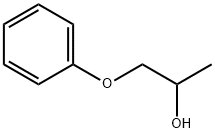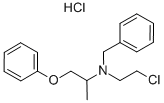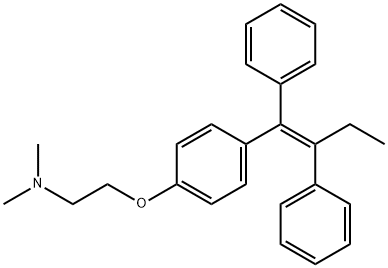1-Phenoxy-2-propanol
Synonym(s):DOWANOL PPh;Propylene glycol phenyl ether;Propylene phenoxytol
- CAS NO.:770-35-4
- Empirical Formula: C9H12O2
- Molecular Weight: 152.19
- MDL number: MFCD00016861
- EINECS: 212-222-7
- SAFETY DATA SHEET (SDS)
- Update Date: 2024-12-18 14:08:52

What is 1-Phenoxy-2-propanol?
Chemical properties
colourless liquid
The Uses of 1-Phenoxy-2-propanol
1-Phenoxy-2-propanol is a useful synthetic intermediate. It was used in the preparation of acylarylthiocarbamates as nonnucleoside reverse transcriptase inhibitors.
The Uses of 1-Phenoxy-2-propanol
High-boiling solvent, bactericidal agent, fixa- tive for soaps and perfumes, intermediate for plas- ticizers.
Definition
Colorless liquid.Combustible.
What are the applications of Application
1-Phenoxy-2-propanol (PP) is used as a preservative in cosmetics. PP is currently permitted for up to 1% in cosmetic formulations in Korea and Europe. In addition to its cosmetic uses, PP is used as a solvent for mixing water and organic components in paints, coatings, and films. It is used as an ink solvent for industrial paints, ballpoint pens, stamp pads, and paint removers. The exposure range is broad since PP is used in various industrial paints and cosmetic
Synthesis Reference(s)
Tetrahedron Letters, 36, p. 9357, 1995 DOI: 10.1016/0040-4039(95)02027-M
General Description
1-Phenoxy-2-propanol (PP), a gycol ether, can be synthesized by reacting propylene oxide with phenol in the presence of Al2O3-MgO/Fe3O4 catalyst. The influence of its anesthetic property on gastropods has been analyzed. Its degradation by microorganisms in different soil types has been investigated.
Flammability and Explosibility
Non flammable
Safety Profile
Moderately toxic by ingestion and skin contact. Experimental reproductive effects. When heated to decompositionit emits acrid smoke and irritating vapors.
Toxicity evaluation
1-Phenoxy-2-propanol (PP) does not cause skin irritation or sensitization. However, it may induce mucosal irritation. The pregnant Himalayan rabbits were orally administered 0, 60, 180, and 540?mg/kg/day of PP during organogenesis (7–19 days of pregnancy). LOAEL (Lowest Observed Adverse Effect Level) for maternal toxicity was assessed at 540?mg/kg/day based on weight loss and apathy. In addition, LOAEL for developmental toxicity was 540?mg/kg/day, and NOAEL (No Observed Adverse Effect Level) was assessed at 180?mg/kg/day. The other study reported that NOAEL for maternal toxicity of PP orally treated to pregnant Wistar rats was 40?mg/kg/day, and NOAEL for developmental toxicity of PP was 160?mg/kg/day.
Regulations
1-Phenoxy-2-propanol (PP) has antibacterial properties and is designated as a sterilizing and preserving agent used in cosmetics and soaps. In Korea, PP comprises up to 1.0% of formulations and is only allowed in products that are washed off after use, and other products are prohibited. European Commission (EC) restricts washing products to 1.0% or less[1].
References
[1] Jung Dae Lee . “Percutaneous permeability of 1-phenoxy-2-propanol, a preservative in cosmetics.” Regulatory Toxicology and Pharmacology 103 (2019): Pages 56-62.
Properties of 1-Phenoxy-2-propanol
| Melting point: | 11 °C |
| Boiling point: | 243 °C (lit.) |
| Density | 1.064 g/mL at 20 °C (lit.) |
| vapor pressure | 1Pa at 20℃ |
| refractive index | n |
| Flash point: | >230 °F |
| storage temp. | Refrigerator |
| solubility | water: soluble15.1g/L at 20°C |
| form | Oil |
| pka | 14.43±0.20(Predicted) |
| Specific Gravity | 1.051 |
| color | Clear Colourless |
| Water Solubility | 15.1g/L at 20℃ |
| BRN | 1941356 |
| Stability: | Stable. Flammable. Incompatible with strong oxidizing agents. |
| CAS DataBase Reference | 770-35-4(CAS DataBase Reference) |
| NIST Chemistry Reference | 1-Phenoxy-2-propanol(770-35-4) |
| EPA Substance Registry System | 1-Phenoxy-2-propanol (770-35-4) |
Safety information for 1-Phenoxy-2-propanol
| Signal word | Warning |
| Pictogram(s) |
 Exclamation Mark Irritant GHS07 |
| GHS Hazard Statements |
H319:Serious eye damage/eye irritation |
| Precautionary Statement Codes |
P280:Wear protective gloves/protective clothing/eye protection/face protection. P305+P351+P338:IF IN EYES: Rinse cautiously with water for several minutes. Remove contact lenses, if present and easy to do. Continuerinsing. P337+P313:IF eye irritation persists: Get medical advice/attention. |
Computed Descriptors for 1-Phenoxy-2-propanol
1-Phenoxy-2-propanol manufacturer
LANXESS India Pvt. Ltd.
New Products
(S)-3-Aminobutanenitrile hydrochloride 4-Methylphenylacetic acid N-Boc-D-alaninol N-BOC-D/L-ALANINOL Tert-butyl bis(2-chloroethyl)carbamate 3-Morpholino-1-(4-nitrophenyl)-5,6-dihydropyridin- 2(1H)-one Furan-2,5-Dicarboxylic Acid Tropic acid 1-Bromo-3,5-Di-Tert-Butylbenzene S-2-CHLORO PROPIONIC ACID ETHYL ISOCYANOACETATE 2-Bromo-1,3-Bis(Dimethylamino)Trimethinium Hexafluorophosphate 4-IODO BENZOIC ACID 3-NITRO-2-METHYL ANILINE 1-(2,4-DICHLOROPHENYL) ETHANAMINE (2-Hydroxyphenyl)acetonitrile 4-Bromopyrazole 2-(Cyanocyclohexyl)acetic acid 4-methoxy-3,5-dinitropyridine 1-(4-(aminomethyl)benzyl)urea hydrochloride 2-aminopropyl benzoate hydrochloride diethyl 2-(2-((tertbutoxycarbonyl)amino) ethyl)malonate tert-butyl 4- (ureidomethyl)benzylcarbamate Ethyl-2-chloro((4-methoxyphenyl)hydrazono)acetateRelated products of tetrahydrofuran








You may like
-
 1-Phenoxy-2-propanol CAS 770-35-4View Details
1-Phenoxy-2-propanol CAS 770-35-4View Details
770-35-4 -
 1-Phenoxy-2-propanol CAS 770-35-4View Details
1-Phenoxy-2-propanol CAS 770-35-4View Details
770-35-4 -
 1-Phenoxy-2-propanol, ≥99% CAS 770-35-4View Details
1-Phenoxy-2-propanol, ≥99% CAS 770-35-4View Details
770-35-4 -
 1-Phenoxy-2-propanol, ≥93% CAS 770-35-4View Details
1-Phenoxy-2-propanol, ≥93% CAS 770-35-4View Details
770-35-4 -
 1-Phenoxy-2-propanol CAS 770-35-4View Details
1-Phenoxy-2-propanol CAS 770-35-4View Details
770-35-4 -
 770-35-4 1-Phenoxyisopropanol 98%View Details
770-35-4 1-Phenoxyisopropanol 98%View Details
770-35-4 -
 14714-50-2 (2-Hydroxyphenyl)acetonitrile 98+View Details
14714-50-2 (2-Hydroxyphenyl)acetonitrile 98+View Details
14714-50-2 -
 118753-70-1 98+View Details
118753-70-1 98+View Details
118753-70-1